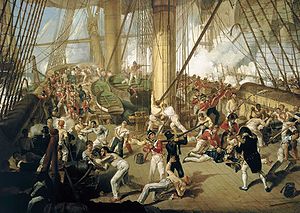- Denis Dighton
-
Denis Dighton (1792 – 8 August 1827) was an English painter, best known for his military portraits and battle scenes.
Contents
Life
Denis Dighton was the son of the caricaturist Robert Dighton. He studied at the Royal Academy. At the age of seventeen he received a commission in the army, through the influence of the Prince of Wales, who had been a close friend of his mother. However, he soon returned to civilian life, and enrolled as a student of the Royal Academy in 1807. He subsequently exhibited 17 pictures there between 1811 and 1825.[1] By 1814 he had received the title of Military Painter to H.R.H. the Prince Regent. The prince sent Dighton to Belgium just before the Battle of Waterloo, and seems to have bought all his exhibited pictures.[2]
He subsequently fell from royal favour when his intermediary with the Prince Regent, Sir Benjamin Bloomfield, lost his place in the royal household, to be replaced by Sir William Knighton. After this loss of patronage, Dighton became mentally ill; he moved with his wife and son to Brittany, where he lived supported by the Artists' Fund until his death at the age of 35 on 8 August, 1827.[1]
Denis Dighton is mostly known for his paintings of battle scenes especially depicting the Peninsular War and the Battle of Waterloo; he also painted a scene of Nelson being shot at the Battle of Trafalgar.
He was married to Phoebe Earl, flower painter to Queen Adelaide, in 1815.
Paintings
- The Storming of San Sebastian on the 31st of August (1814 - National Trust for Scotland, Leith Hall)
- Battle of Orthes (1815 - Marquess of Anglesey)
- The Battle of Waterloo (1816 - Marquess of Anglesey)
- Waterloo - Charge of the Second Brigade of Cavalry (1817)[3]
- Battle of Waterloo (attributed) (Army and Navy Club, London)
- Greeks and Turks. Defeat of the Turks in the Defile of Klissura (1823 - Private Collection)
Works about
- Carman, William Y., "The Battle of Waterloo by Denis Dighton," Journal of the Society for Army Historical Research, Vol. XLIII, No. 174, June 1965, pp. 55-59.
- Harrington, Peter. (1993). British Artists and War: The Face of Battle in Paintings and Prints, 1700-1914. London: Greenhill
References
- ^ a b Pye, John (1845). Patronage of British art. London. p. 387. http://books.google.co.uk/books?id=2sCfAAAAMAAJ&printsec=frontcover#v=onepage&q&f=false. Retrieved 14 June 2011.
- ^ Hichberger, J.W.M. (1991). Images of the Army: The Military in British Art, 1815-1914. Manchester University Press.
- ^ Royal Collection
External links

This biographical article about a painter from the United Kingdom is a stub. You can help Wikipedia by expanding it.

